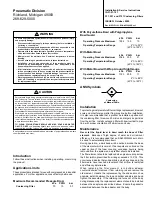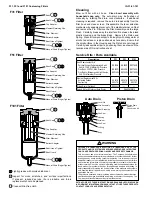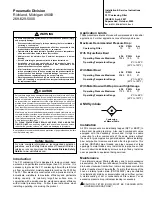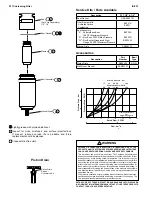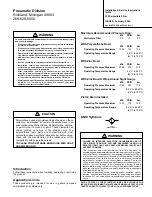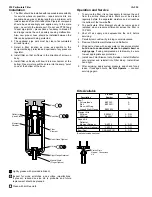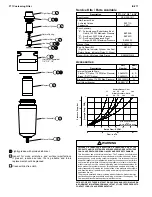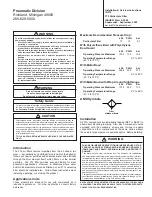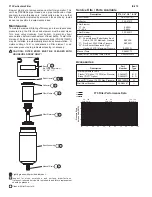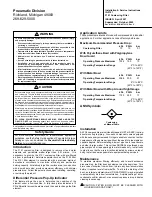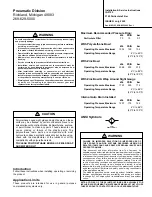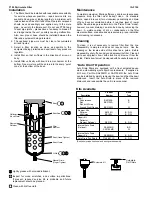
Pneumatic Division
Richland, Michigan 49083
269-629-5000
Installation & Service Instructions
IS-31-51-101
F31, F51 and F101 Coalescing Filters
ISSUED: October, 2005
Doc. #IS3151101, ECN #050998, Rev. 1
Introduction
Follow these instructions when installing, operating, or servicing
the product.
Application Limits
These products are intended for use with compressed air in industrial
applications. For other applications, consult factory before use.
Maximum Recommended Pressure Drop:
kPa
PSIG
bar
Coalescing Filter
70
10
0.7
With Polyurethane Bowl with Polypropylene
Bowl Guard
kPa
PSIG
bar
Operating Pressure Maximum
1034
150
10
Operating Temperature Range
4°C to 52°C
(40°F to 125°F)
With Metal Bowl
kPa
PSIG
bar
Operating Pressure Maximum
2068
300
21
Operating Temperature Range
4°C to 82°C
(40°F to 180°F)
With Metal Bowl with Wrap Around Sight Gauge
kPa
PSIG
bar
Operating Pressure Maximum
1723
250
17
Operating Temperature Range
4°C to 66°C
(40°F to 150°F)
ANSI Symbols
Installation
To protect against premature filter cartridge replacement, blow out
scale and other foreign matter from pipe line before installation.
It is also recommended that a prefilter be installed, upstream of
the coalescing filter, to remove 40 micron and larger size particles
from the air line. Install coalescing filter with bowl vertical to pipe
line, with proper orientation of flow arrows on body.
Maintenance
Never let the liquid level in bowl reach the base of filter
element. Because of high degree of water and oil removal
efficiency, it is recommended that an SA602MD-M4 auto drain
be used to automatically drain bowl.
During operation, a dark band will be noticed around the base
of the element which is normal. If dark spots are noticed on the
upper portion of the foam covering, excessive liquid is being
removed from the system and a prefilter should be installed.
The filter element should be replaced when pressure drop across
the filter (within prescribed flow range) exceeds 10 PSI. This
occurrence indicates that solid particles, which are trapped in the
filter media, have reached a level such that air flow is restricted
and efficiency deteriorates.
When replacing the filter element, turn bottom adapter
counterclockwise to remove it from retaining rod and remove the
old element. Handle the replacement by the ends as much as
possible, install it between the top and bottom adapters and hand
tighten the assembly. If the retaining rod turns out of the body
during disassembly, the replacement element should be installed
between the adapters as described above. Ensure the gasket is
assembled between the top adapter and the body.
WARNING
To avoid unpredictable system behavior that can cause personal injury
and property damage:
• Disconnect electrical supply (when necessary) before installation,
servicing, or conversion.
• Disconnect air supply and depressurize all air lines connected to this
product before installation, servicing, or conversion.
• Operate within the manufacturer’s specified pressure, temperature,
and other conditions listed in these instructions.
• Medium must be moisture-free if ambient temperature is below
freezing.
• Service according to procedures listed in these instructions.
• Installation, service, and conversion of these products must be
performed by knowledgeable personnel who understand how
pneumatic products are to be applied.
• After installation, servicing, or conversion, air and electrical supplies
(when necessary) should be connected and the product tested for
proper function and leakage. If audible leakage is present, or the
product does not operate properly, do not put into use.
• Warnings and specifications on the product should not be covered by
paint, etc. If masking is not possible, contact your local representative
for replacement labels.
!
!
CAUTION
Polyurethane bowls, being transparent and tough, are ideal for use with Filters
and Lubricators. They are suitable for use in normal industrial environments, but
should not be located in areas where they could be subjected to direct sunlight,
an impact blow, nor temperatures outside of the rated range. As with most
plastics, some chemicals can cause damage. Polyurethane bowls should not
be exposed to chlorinated hydrocarbons, ketones, esters and certain alcohols.
They should not be used in air systems where compressors are lubricated with
fire-resistant fluids such as phosphate ester and di-ester types.
Metal bowls are recommended where ambient and/or media conditions are not
compatible with polyurethane bowls. Metal bowls resist the action of most such
solvents, but should not be used where strong acids or bases are present or
in salt laden atmospheres. Consult the factory for specific recommendations
where these conditions exist.
TO CLEAN POLYURETHANE BOWLS USE MILD SOAP AND WATER
ONLY! DO NOT use cleansing agents such as acetone, benzene, carbon
tetrachloride, gasoline, toluene, etc., which are damaging to this plastic.
Bowl guards are recommended for added protection of polyurethane bowls where
chemical attack may occur.
Coalescing
w/ Manual Drain


